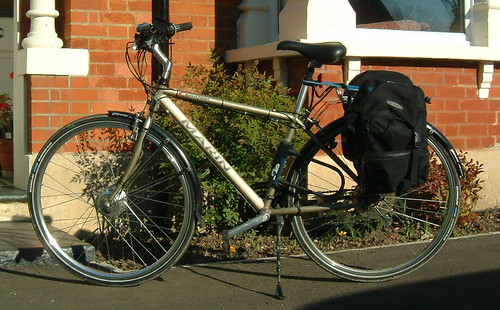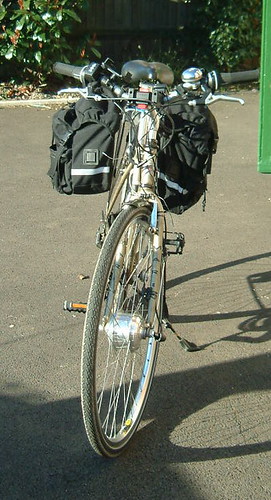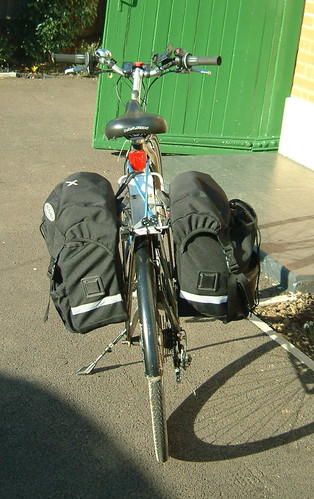UPDATE - 19 October 2008 - Fixed it; see new post at the end for details!
UPDATE - 21 February 2008 - the motor is not now working. I believe it is a controller problem but have not been able to investigate. I've also heard reports of others having both motor and controller problems so, as things stand, would not recommend a Tongxin motor

I have now done almost 100 miles with my Tongxin kit powered bike. There has been a bit of interest in these motors so I thought I'd post something on its performance.
The Tongxin motor
The Tongxin motor has particular strengths and weaknesses as a result of its unusual design, which is that instead of internal gears with teeth, it has rollers, which are smaller and quieter but not as strong.
Its biggest strength is that it has very low rolling resistance, enabling the bike to handle virtually the same as a normal un-powered bike. Also it is extremely small and light. It is only about 10cm in diameter and weighs only 2.5kg, which is perhaps half the weight of most commonly used motors. It is also very quiet. Its weakness is that the roller may slip if asked to deliver very high torque.
It has been used in several applications - with some successes and some failures. The best known in the UK is the Nano - a kit produced by Tony Castles for the Brompton and with a generic version for other bikes. This received rave reviews from AtoB magazine. Also well publicised is the Schwinn, which was a failure due to controller problems (using a non-Tongxin controller). There are reports on the internet of people having Tongxin controller problems. There are also rumours that people have had problems with the roller drive slipping. While I have not been able to find any actual examples, I believe that this is a risk if the motor is put in situations where very high torque is demanded.
My objective
I wanted to create the best bike for my commute to and from work. This is a 12.5 mile each way journey across relatively flat, straight roads in Central / West London. I wanted it to be light, quiet, look discreet and give a good combination of speed and economy on my route. One thing I don't need is exceptional hill-climbing ability, as the biggest hill I go up is Holland Park Avenue, which can't be more than 1 in 15 (ie not very steep!), and which even my wife's Powacycle is able to go up at 12+mph.
My design
To achieve this I decided to fit a 260 rpm Tongxin motor - designed to be able to give around 15mph in a 16 inch wheel - to the 700c wheel of my bike. This has the effect of overgearing the motor, to a similar extent to the Suzhou Bafang motor in the classic Torq. I expected to end up with a similar result to the Torq - ie fast but not great on hills. I discussed my plans with Tongxin and they felt it would work. I also came across a chap in Australia on the Endless Sphere forum, who had made the same configuration and was happy with the results.
I can't emphasise enough that this is not a bike designed for use on steep hills. Furthermore I don't use the motor until I've got the bike going (to 5mph+) or use motor without pedalling.
I went for a 36v motor to reduce the current levels - but 24v would have been an option. The bike I am using is a steel-framed, no-suspension Marin city bike which is about 7 years old and on which I have ridden many many unpowered miles. It's a mid-range bike, being quite light with reasonable components, and pleasant to ride. The new version now costs about £300.
Ordering
I bought the kit direct from Tongxin. I found them easy to deal with. The prices were extremely reasonable - £113 to my door for the motor, controller, two throttles and brakes. This included money transfer fee of £21 but it got through customs with no duty or VAT.
Fitting
Unlike many on this forum, I'm not an engineer, have limited experience of making things. I bought a soldering iron off eBay and set to work when the kit had arrived. I had wanted to fit it to the back wheel but there were two problems. Firstly I didn't think it through before having my wheel built and didn't get it dished to accomodate the freewheel. Secondly, I'm not sure that the axle would be long enough for my rear forks. So I put it in the front. This required me to stretch the forks apart slightly, but with a bit of pulling it was ok. My plan was to keep the installation on the bike as minimalist as possible and carry the battery and controller in a rack-bag or pannier - removing when I park. I put everything else together - getting email support from Tongxin on which wire had to go where. I learned to solder, and got the wires tidily arranged so they didn't look too obtrusive.
Performance.
I went for my first short test ride and was highly impressed with the speed I was getting (20-24mph) on the local roads and how the bike felt at those speeds - how the 700c wheels and steel frame gave an exceptionally smooth ride compared to aluminium electric bikes with 26" wheels. On my next ride, the results were also great - but the bike broke down. I thought it was the controller and contacted Tongxin. They asked me to send it back which I did and they sent me a replacement with no quibble. I now realise that there was not actually a controller fault but it was my battery (an SLA I was using for initial test) - so apologies to Tongxin! Unfortunately this led to a delay of a month - but I got it going again about a week ago.
Performance in the last week has been great. It can cruise for mile after mile at 20+mph. With a litte effort 25mph on the flat is possible and 22 can be sustained for a long period. It climbs all my hills at 15+mph. The first day it got me to work in 41 minutes, a full five minutes faster than my Wisper and 14 minutes faster than the Marin without motor. Probably the main reason it performs well is the cycling quality of the actual bike, which is not impaired by the presence of the Tongxin motor. It is so much more pleasant to ride than any electric bike I have ridden, and more efficient. Without the motor I can easily ride the bike at about 16mph on the flat, compared to about 12mph for other hub motor bikes, so the motor doesn't have as much work to do. If I release the throttle when going at speed, the bike carries on going, only dropping speed very gradually due to the much lower resistance of the Tongxin than other hub motors.
Having the motor in the front wheel has actually been fine. It's so light that it doesn't affect the way the bike feels and I don't get any of the hammering often experienced from heavier motors (eg on Ezees and Powabykes).
Verdict
It's a joy to ride. Far, far better than any other electric bike I have ridden. It is ideal for my journey. I would recommend it without hesitation to anyone who had similar requirements to me and who is willing to pedal while using the motor. I would not recommend this configuration for anyone who didn't want to pedal much, wanted to use the motor from stationary and who had hills to contend with - although a lower geared Tongxin might still be a good option. Having ridden this bike I can fully understand why AtoB gave 5 stars to the Nano application of the Tongxin in a Brompton folder (whereas beforehand it seemed incomprehensible!)
Is it legal?
No, as it gives assistance at above 15.5mph - like the Torq, Wisper and even others such as the Ezee Liv. It is well within legal power limits so it is only gearing that takes it outside the law. Indeed, in Australia, which is generally reckoned to have more restrictive e-bike laws, but where they are based on power, not speed, it would be legal.
Frank
UPDATE - 21 February 2008 - the motor is not now working. I believe it is a controller problem but have not been able to investigate. I've also heard reports of others having both motor and controller problems so, as things stand, would not recommend a Tongxin motor

I have now done almost 100 miles with my Tongxin kit powered bike. There has been a bit of interest in these motors so I thought I'd post something on its performance.
The Tongxin motor
The Tongxin motor has particular strengths and weaknesses as a result of its unusual design, which is that instead of internal gears with teeth, it has rollers, which are smaller and quieter but not as strong.
Its biggest strength is that it has very low rolling resistance, enabling the bike to handle virtually the same as a normal un-powered bike. Also it is extremely small and light. It is only about 10cm in diameter and weighs only 2.5kg, which is perhaps half the weight of most commonly used motors. It is also very quiet. Its weakness is that the roller may slip if asked to deliver very high torque.
It has been used in several applications - with some successes and some failures. The best known in the UK is the Nano - a kit produced by Tony Castles for the Brompton and with a generic version for other bikes. This received rave reviews from AtoB magazine. Also well publicised is the Schwinn, which was a failure due to controller problems (using a non-Tongxin controller). There are reports on the internet of people having Tongxin controller problems. There are also rumours that people have had problems with the roller drive slipping. While I have not been able to find any actual examples, I believe that this is a risk if the motor is put in situations where very high torque is demanded.
My objective
I wanted to create the best bike for my commute to and from work. This is a 12.5 mile each way journey across relatively flat, straight roads in Central / West London. I wanted it to be light, quiet, look discreet and give a good combination of speed and economy on my route. One thing I don't need is exceptional hill-climbing ability, as the biggest hill I go up is Holland Park Avenue, which can't be more than 1 in 15 (ie not very steep!), and which even my wife's Powacycle is able to go up at 12+mph.
My design
To achieve this I decided to fit a 260 rpm Tongxin motor - designed to be able to give around 15mph in a 16 inch wheel - to the 700c wheel of my bike. This has the effect of overgearing the motor, to a similar extent to the Suzhou Bafang motor in the classic Torq. I expected to end up with a similar result to the Torq - ie fast but not great on hills. I discussed my plans with Tongxin and they felt it would work. I also came across a chap in Australia on the Endless Sphere forum, who had made the same configuration and was happy with the results.
I can't emphasise enough that this is not a bike designed for use on steep hills. Furthermore I don't use the motor until I've got the bike going (to 5mph+) or use motor without pedalling.
I went for a 36v motor to reduce the current levels - but 24v would have been an option. The bike I am using is a steel-framed, no-suspension Marin city bike which is about 7 years old and on which I have ridden many many unpowered miles. It's a mid-range bike, being quite light with reasonable components, and pleasant to ride. The new version now costs about £300.
Ordering
I bought the kit direct from Tongxin. I found them easy to deal with. The prices were extremely reasonable - £113 to my door for the motor, controller, two throttles and brakes. This included money transfer fee of £21 but it got through customs with no duty or VAT.
Fitting
Unlike many on this forum, I'm not an engineer, have limited experience of making things. I bought a soldering iron off eBay and set to work when the kit had arrived. I had wanted to fit it to the back wheel but there were two problems. Firstly I didn't think it through before having my wheel built and didn't get it dished to accomodate the freewheel. Secondly, I'm not sure that the axle would be long enough for my rear forks. So I put it in the front. This required me to stretch the forks apart slightly, but with a bit of pulling it was ok. My plan was to keep the installation on the bike as minimalist as possible and carry the battery and controller in a rack-bag or pannier - removing when I park. I put everything else together - getting email support from Tongxin on which wire had to go where. I learned to solder, and got the wires tidily arranged so they didn't look too obtrusive.
Performance.
I went for my first short test ride and was highly impressed with the speed I was getting (20-24mph) on the local roads and how the bike felt at those speeds - how the 700c wheels and steel frame gave an exceptionally smooth ride compared to aluminium electric bikes with 26" wheels. On my next ride, the results were also great - but the bike broke down. I thought it was the controller and contacted Tongxin. They asked me to send it back which I did and they sent me a replacement with no quibble. I now realise that there was not actually a controller fault but it was my battery (an SLA I was using for initial test) - so apologies to Tongxin! Unfortunately this led to a delay of a month - but I got it going again about a week ago.
Performance in the last week has been great. It can cruise for mile after mile at 20+mph. With a litte effort 25mph on the flat is possible and 22 can be sustained for a long period. It climbs all my hills at 15+mph. The first day it got me to work in 41 minutes, a full five minutes faster than my Wisper and 14 minutes faster than the Marin without motor. Probably the main reason it performs well is the cycling quality of the actual bike, which is not impaired by the presence of the Tongxin motor. It is so much more pleasant to ride than any electric bike I have ridden, and more efficient. Without the motor I can easily ride the bike at about 16mph on the flat, compared to about 12mph for other hub motor bikes, so the motor doesn't have as much work to do. If I release the throttle when going at speed, the bike carries on going, only dropping speed very gradually due to the much lower resistance of the Tongxin than other hub motors.
Having the motor in the front wheel has actually been fine. It's so light that it doesn't affect the way the bike feels and I don't get any of the hammering often experienced from heavier motors (eg on Ezees and Powabykes).
Verdict
It's a joy to ride. Far, far better than any other electric bike I have ridden. It is ideal for my journey. I would recommend it without hesitation to anyone who had similar requirements to me and who is willing to pedal while using the motor. I would not recommend this configuration for anyone who didn't want to pedal much, wanted to use the motor from stationary and who had hills to contend with - although a lower geared Tongxin might still be a good option. Having ridden this bike I can fully understand why AtoB gave 5 stars to the Nano application of the Tongxin in a Brompton folder (whereas beforehand it seemed incomprehensible!)
Is it legal?
No, as it gives assistance at above 15.5mph - like the Torq, Wisper and even others such as the Ezee Liv. It is well within legal power limits so it is only gearing that takes it outside the law. Indeed, in Australia, which is generally reckoned to have more restrictive e-bike laws, but where they are based on power, not speed, it would be legal.
Frank
Last edited:











